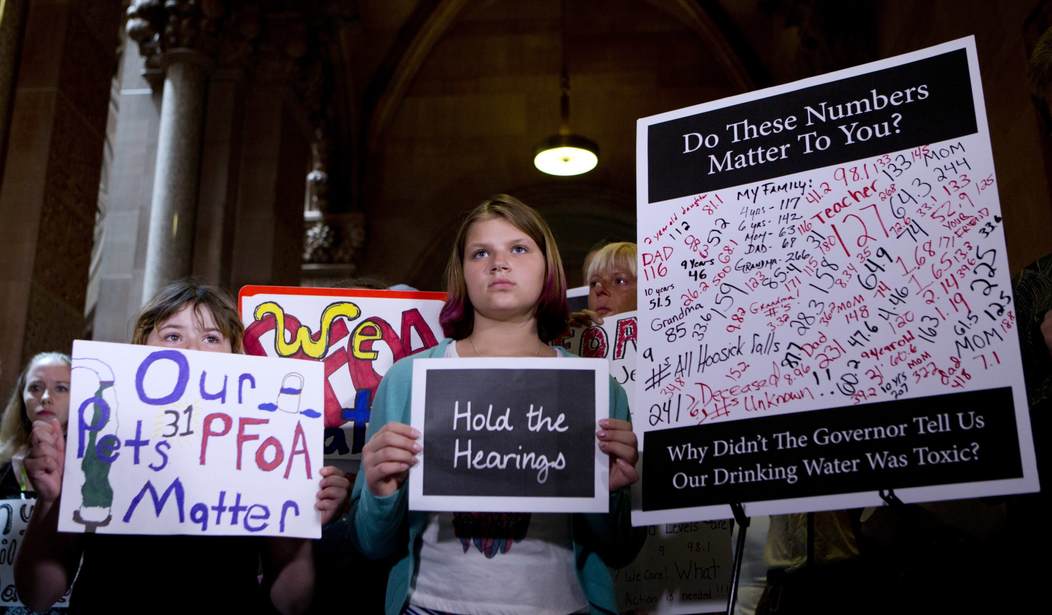Michele Baker is fed up with being ignored by Albany.
“We need to know who polluted our water, why it was polluted, and moreover why Governor Cuomo let us continue to drink contaminated water for 18 months,” Baker told Time Warner Cable News.
Baker wants to find out if New York Gov. Andrew Cuomo (D) knew she and her family in Hoosick Falls, N.Y., were drinking water at home that was polluted with the PFOA chemical, and how long his administration might have covered up the answer.
Hoosick Falls is a small town north of Albany. The people who call the village home found out a year-and-a-half ago that a manmade chemical, perfluorooctanoic acid (PFOA), which is used in the process of making Teflon, was in the water.
The PFOA pollution in Hoosick Falls could be connected to a plastics manufacturing factory operated by St. Gobain, a French corporation. However, Politico New York reported receiving documents that showed an old village dump that tested positive for PFOA had been leaking the toxic chemical directly into Hoosick Falls’ water supply.
The American Cancer Society said PFOA could be found in almost everyone’s blood, worldwide. But it is usually found at very low levels and is not a concern.
However, the International Agency for Research on Cancer, while admitting the evidence is limited, has classified PFOA as “possibly carcinogenic to humans.”
PFOA has been found in dangerously high levels in the Hoosick Falls village water system, and the New York Department of Public Health has confirmed that some people who live in Hoosick Falls have the toxic chemical in their blood.
The New York Senate will conduct a hearing into the problem of drinking water contamination in the Hoosick Falls area, but there is no guarantee the panel will examine the performance of the state Health Department and local officials.
After nearly seven hours of government testimony, Baker, along with her friends and neighbors will finally get to ask questions and tell state officials Aug. 30 what they think of not being told about drinking contaminated water for a year-and-a-half.
Baker can hardly wait to let loose.
“It’s going to be very, very direct. We need answers,” said Baker.
Republicans control the New York Senate. They came late to the Hoosick Falls party after Democrats, who run the state assembly, announced an investigation into how state and local officials reacted to the discovery of a toxic chemical in the town’s water supply two years ago.
Assembly Democrats planned to be in Hoosick Falls in early September to launch their investigation.
The U.S. House Committee on Oversight and Government Reform is also looking into what went wrong with the drinking water in Hoosick Falls, and how state, local and federal officials responded.
New York State officials, who have been criticized for their performance, accused the EPA of not doing its job. The Times Union reported that local officials have been denounced for being allied too closely with St. Gobain corporate officials.
“My hope for the outcome of these hearings would be a streamlined process for a community to follow when a new, unregulated contaminant is discovered in its drinking water supply,” Hoosick Falls village Mayor David Borge told the Times Union.
If there is any good news out of Albany for the people of Hoosick Falls, it is that Gov. Cuomo has signed legislation extending the statute of limitations for those exposed to toxic chemicals in the state of New York.
“Cried tears of joy, just thrilled for everyone,” Jed Donavan, a Hoosick Falls resident, told News 10 ABC when he heard the news about having more time to file a personal injury lawsuit.
Donavan said he drank the water in Hoosick Falls for more than five years and suffered two illnesses caused by the PFOA chemical.
He said it is only right that people like him have more time to sue.
“Let’s say we all decided to go and do something destructive to their property; we would be accountable then,” Donavan said. “We would face the music you know, so it’s not like we’re going to be able to go get even.”
Being afforded more time to go to court is fine, but Donovan also wants New York State officials to create a fund for the victims of PFOA.
“I hope that the goal of the hearings is that we send a strong message to the rest of New York state and possibly the rest of the country,” Michele Baker said, “that if you know that the water is contaminated or there is a problem, just speak up.”









Join the conversation as a VIP Member